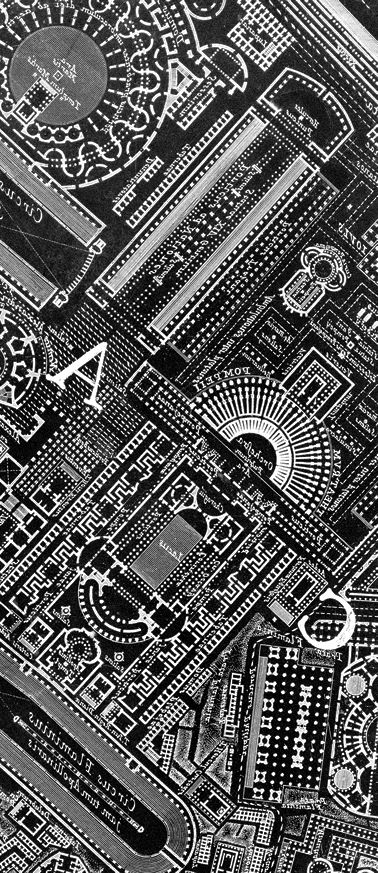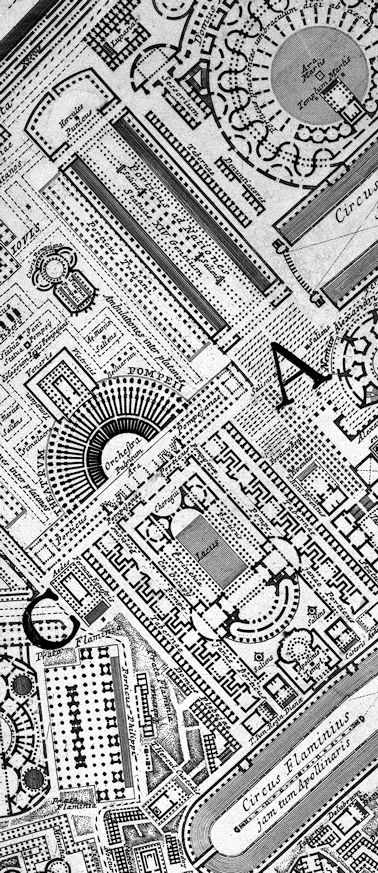Inside the Density of G. B. Piranesi's Ichnographia Campus Martius
virtual 1 obs : of, relating to, or possessing a power of acting without the agency of matter 2 : notably effective 3 : being functionally or effectively but not formally of its kind
The Ichnographia Campus Martius was originally an etched metallic plate, but has since come down to us as a printed plan carved in virtual stone. Piranesi's plan of the Campo Marzio evokes the Forma urbis as if it too were a genuine piece of archaeological evidence. As a veritable document, however, the Ichnographia Campus Martius lacks authenticity--the stones are not real, the carving is not real, and the plans within the plan are by and large inaccurate if not altogether fantastic. Moreover, this overall self-evident fraudulence is unquestionably why most historians and theorists of architecture unanimously concur (with Tafuri) that the Ichnographia Campus Martius is a "formless heap of fragments colliding one against the other . . . represented according to a method of arbitrary associations."
The error of this interpretation lies in its failure to recognize that through the Ichnographia Piranesi lifts a dense chunk of historical data out of history and then scrupulously deposits the lot within a virtual realm where all data then delineates an inversion of itself. Bear in mind that this virtual realm, where in simple terms the negative becomes the positive and the positive becomes the negative, precisely defines the working realm of an engraver.
| |
 
| |
1999.11.29 18:50
thanks 4 thanks
Hello Eleni and Elia,
Thank you so much for the wonderful Thanksgiving Dinner on Saturday night.
Eleni, you asked me on Friday morning if I knew St. Helena's name day was 21 May. Since I am a Roman Catholic, I am more familiar with the 18 August feast of St. Helena. In any case, I herewith enclose two email I sent on 21 May 1999 to a design email list I belong to here in the US:
May 21st - the Agonalia
Agonalia - a festival in honor of Janus celebrated in Rome on the 9th of January and the 21st of May.
Janus is my favorite Roman god.
Janus--an old Italian deity. He was represented with a face on the front and another on the back of his head. The month of January was sacred to him, as were all other beginnings. The myth makes him a king of Latium or Etruria, where he hospitably received Saturn when expelled by Jupiter from Crete. He had a small temple in the Forum, with two doors opposite to each other, which in time of war stood open and in time of peace were shut; the temple was trice closed on this account. With reference to his temple, the deity was called Janus geminus or Janus Quirinus.
In its over 1000 year history, Rome was at peace only three times?
I like Janus because he can see in front of him and he can see behind him--into the future and into the past? Also, I like to wonder whether Janus was "two faced" or was he schizophrenic?
Within his large plan of the Campo Marzio, Piranesi applies the label "Circus Agonalis sive Alexandri" to the original Circus of Domitian which is today Rome's Piazza Navona. Albeit obscure information, Piranesi was indeed correct in his designation because the emperor Alexander Severus rebuilt the Circus of Domitian and renamed it in honor of Janus. It is fun to imagine all the big goings-on over 1700 years ago today within what is now the Piazza Navona.
Another monument in honor of Janus that still stands in Rome today is the Arch of Janus Quadrifrons, which is in the Forum Boarium. It is one of those unique four-way arches, and, according to Banister Fletcher, is "of poor design." What is most interesting about this arch, however, is that it was constructed under Constantine the Great after he converted to Christianity. I believe this signifies two important facts. First, the aristocratic and pagan population of Rome still had tremendous influence and power. Second, whoever designed this arch was extremely clever in that Janus, precisely because of his "two faced" nature, was the perfect god to reflect Constantine's own political position--exactly because of his conversion from paganism to Christianity, Constantine himself is Rome's ultimate Janus-like emperor. [Personally, I can't help but believe that it was Constantine's mother Helena (an architect in all but name) that thought all this poignant symbolism through.] And, in an almost too good to be true sense, the Arch of Janus may well have predicted (looked towards) European architecture's next 1200 years: Banister Fletcher notes "it has a simple cross-vault with embedded brick box-ribs at the groins, affording a further instance of the progressive character of Roman construction techniques: such ribs are possibly the prototypes of Gothic rib vaults. [Fletcher is being a little two faced himself here--first the Arch of Janus is not good design, and then the arch is progressive construction!] Could it really be that the first ribbed cross-vaults ever were built in late antiquity? Do these vaults, built by ancient Rome's first Christian emperor, unwittingly and uncannily prophesies a whole new future era of Western architecture? [And is it possible that Helena, besides being the first master architect of Christianity, is also the world's proto-Gothic architect?]
Constantine converted to Christianity the night before the Battle at the Milvian Bridge (28 October 312) which lead into the City of Rome. He saw a vision of the (Christ) Cross in the sky, and hence ordered his troops to paint the (Christ) Cross on their shields. Constantine was victorious over the usurpative emperor Maxentius, and on 29 October entered Rome in triumph. Constantine's mother, St. Helena, is most known for having discovered the True Cross in Jerusalem (most recently dated c. 324-25). If you asked me, I'd say the "signs" surrounding this incredible mother-son team are still appearing.
Agonalia postscript
As odd as it sounds, only after sending the initial Agonalia post did two things occur to me:
1. the space created by the plan of the four-way Arch of Janus essentially forms a cross.
2. Only Helena is honored as a saint in the Roman Catholic Church, and her feast is celebrated the 18th of August. The Greek Orthodox Church, on the other hand (or is it other face), honors both Helena and Constantine as saints, and they share a combined feast day, which happens to be today, 21 May.
So, as I already told you, the fact that I came to Brussels and immediately met two Elenis is no doubt another sign.
|